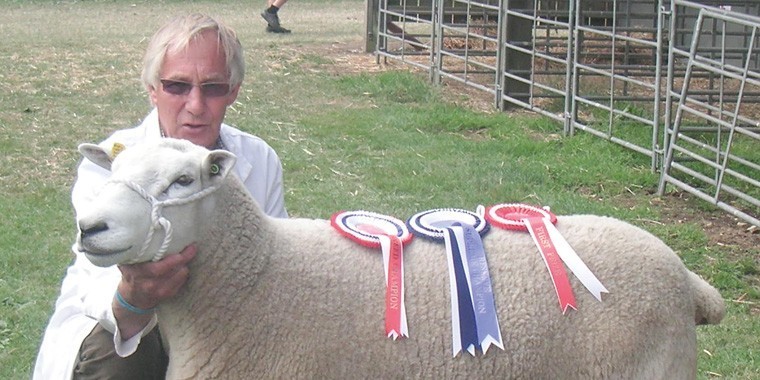At the time of writing (early April) we still have one ewe hanging on. True to form, all expectations of a quick and relatively early end of lambing were confounded by one of the other half’s Herdwick ewes, who obviously returned. She is certainly in lamb, nicely bagged up and full of milk, but simply doing what sheep do best, making life more “interesting”.
The problem arises because the colour and style of the Herwick fleece makes it difficult to select suitable crayon colours; i.e. ones that will show up clearly. Yellow shows for a short time but fades very quickly, leaving only orange and red. The problem is that red, although a bit darker, does not clearly over-mark orange. It’s a problem that I hope we have already addressed, having found some nice, bright, not too dark colours that will (fingers crossed) give us a better indication next tupping season. That’s forward planning!
In the meantime all we can do is be patient and she still looks rather too relaxed, to the point of being smug, but that’s Herdys; quite unlike the Lleyn, who begin to show subtle changes in behaviour a day in advance of lambing, the Herdys provide very little advance notice of lambing, an hour if you are lucky. The Herdys simply select their spot and get on with it. She will no doubt perform when she is ready; an eagerly awaited full stop to lambing which, I hope, will not be too long in arriving.
With just one left, it is sorely tempting to skip a visit or two during the day; it does, after all, get a bit wearying once the first month has passed, but I would hate for anything to go wrong and miss a problem lambing, so they will continue. As a breed they do just get on with it and I doubt if any of my assistance will be wished for or required; in reality I have not seen any Herdy lambs born this season. I’m sure they have worked out the timings of my first morning visit and pop their lambs out just before I arrive, generally finding a ewe with one lamb, on its feet, almost dry, and a second newly born and still wet. Yes, Herdwick will produce twins, although until they finish I would not dare to presume what the final lambing percentage will be.
From what I hear, many other producers have had a relatively quick and easy lambing this year. This is indeed good news, although Schmallenberg seems to have raised its ugly head once again for some. On the plus side, the weather has been fairly kind to us, not too much rain and some beautifully warm days; the latter particularly enjoyed by the lambs. It is lovely to see them flat out, reveling in the warm sunshine. A bit of sun lifts the spirits of both sheep and humans alike. It is also good to see the grass really beginning to grow away; it’s amazing to see how much, after a couple of grey days, the grass will perk up with a bit of warm sunshine, grass that will be particularly valuable this year. The more we can produce from grass the better.
It has been truly dreadful watching the recent horrific events unfold in Ukraine; I’m sure that all of our sympathies go out to the people, although it is impossible for us to fully comprehend how devastating it must be for both them and their country. The impact is being felt well beyond Ukraine and will be quite significant in some of the poorer countries that rely very much on imports of Ukrainian wheat; in poor communities where simply feeding the family absorbs almost 100% of household incomes, recent price increases will mean less food, potentially pushing some into starvation.
The impact in the UK has not been so dramatic, something that we do need to remember; an impact that pales into insignificance when compared to some poorer countries but which nonetheless is feeding through into the sheep sector in higher fuel costs, feed costs and most significantly fertiliser costs. The latter two, in particular, may provide the encouragement that some sheep producers need to give more serious thought to alternative sources of forage. Grass is not the only forage; there is a wide range available to producers, some having the dual advantage of producing significant quantities of good quality feed and fixing significant volumes of free atmospheric nitrogen in the soil, reducing dependence on purchased nitrogen.
Last autumn I trialed a bit of forage rye with vetch (a nitrogen fixer). The rye has been brilliant but I am yet to be convinced about the vetch, although this may come with the warmer weather. Simply broadcast onto permanent pasture, it established so well in the autumn that it had light grazing by some lambs in the back end. The rye came back very well and started growing away well before the grass really took off and has provided some very good, very palatable grazing for the ewes post lambing.
I estimate that this has produced about 2t/ha of DM at a cost of about 8p/kg DM of a feed which will provide about 12% to 15% CP at an ME of 10.5, really not bad. That’s a cheap feed, particularly when compared with an 18% CP, 12.5ME sheep concentrate costing (bag price), somewhere between 41p/kg and 46p/kg. In addition the rye is coming back again and will certainly provide a third, maybe even a fourth, bite. It really is worth considering the options available.




